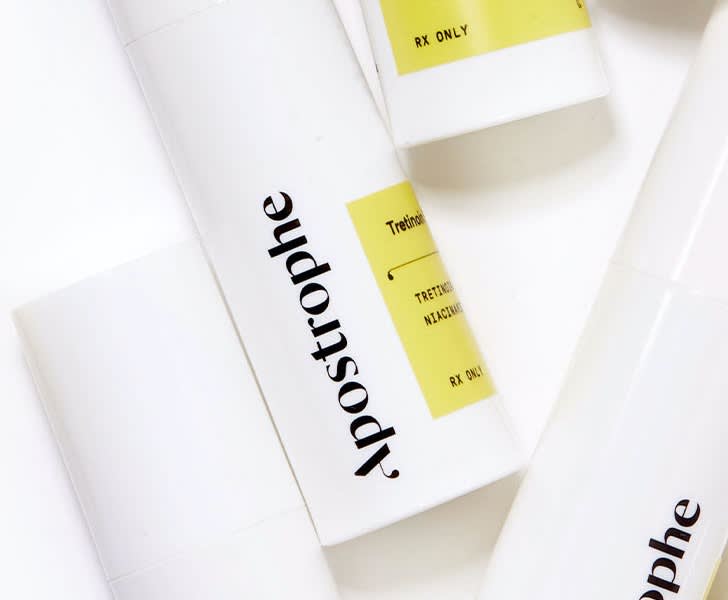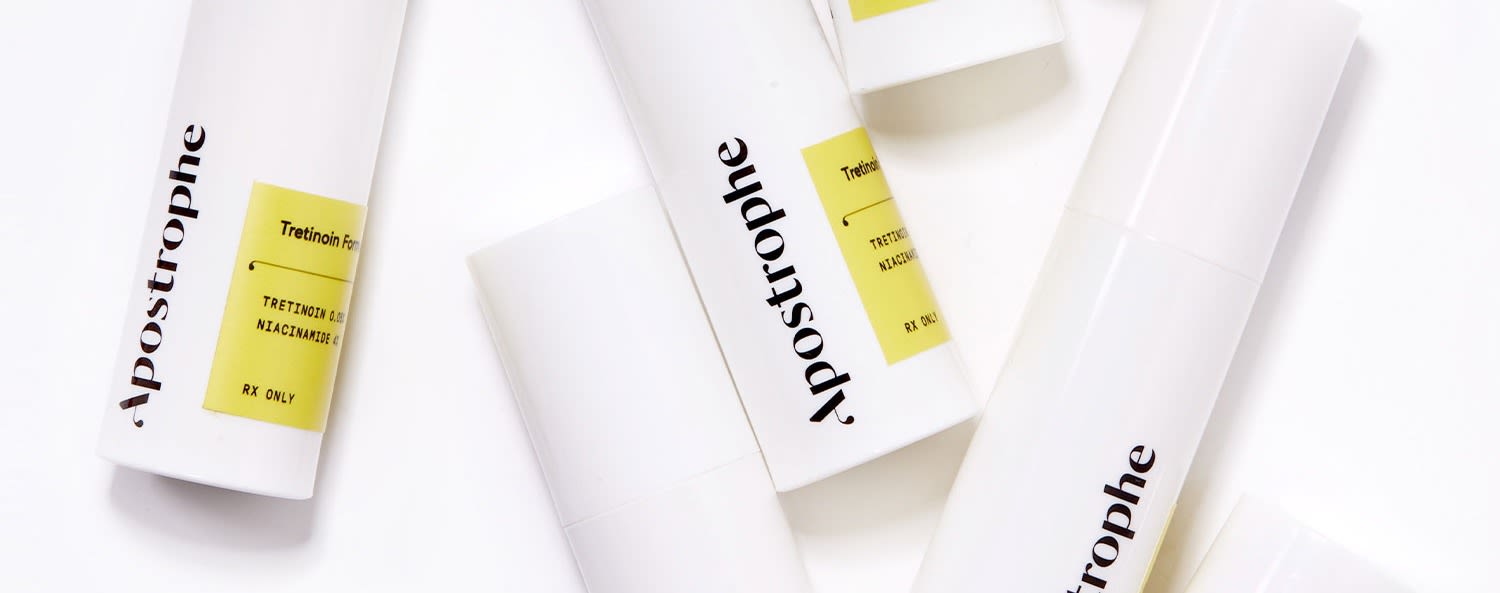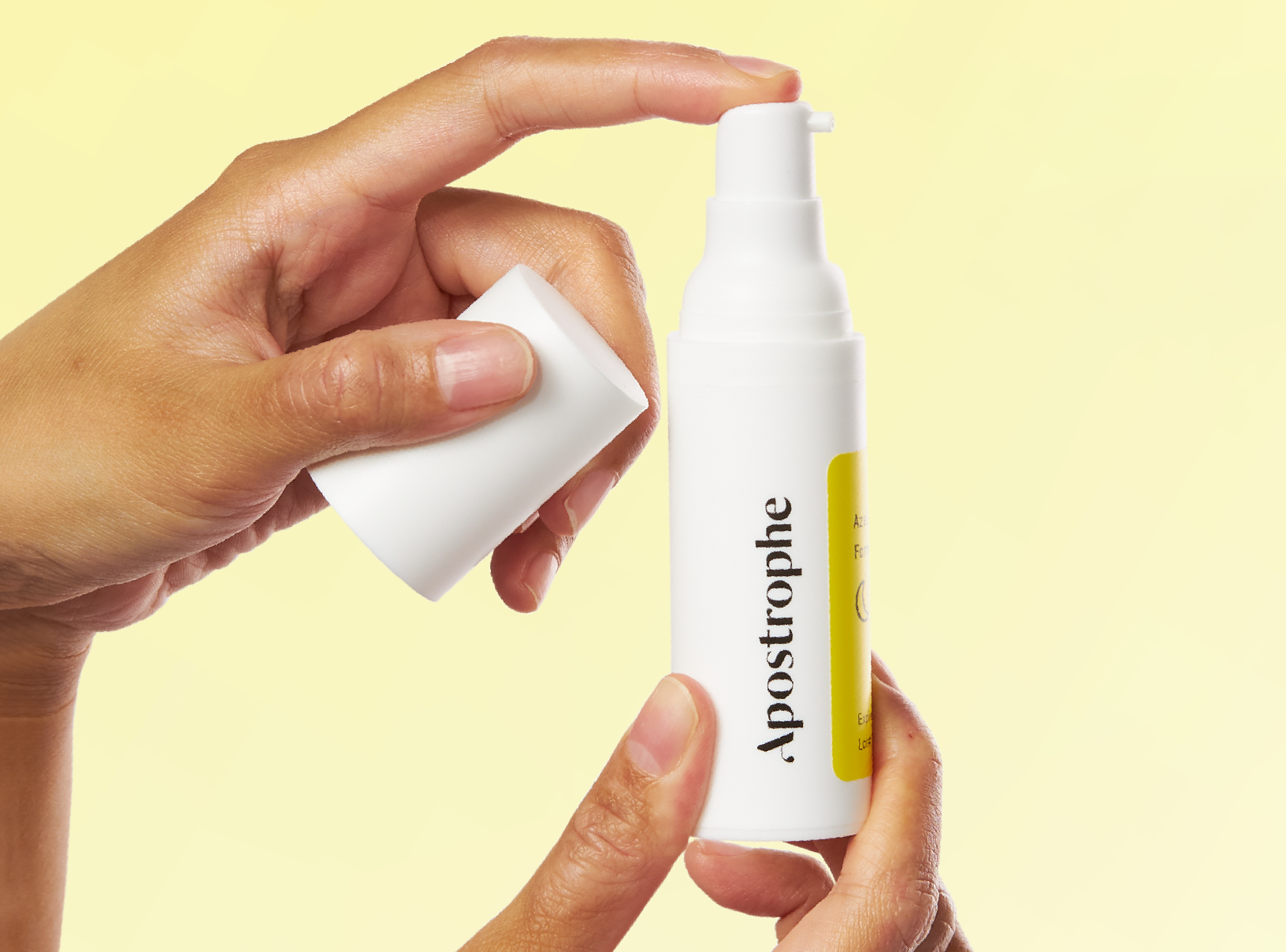Education
How Long Does Tretinoin Take to Reduce Wrinkles?


SHARE
Education
How Long Does Tretinoin Take to Reduce Wrinkles?
Medically reviewed by Mary Lucas, RN
Written by Apostrophe Team
Last updated 8/1/2024
Tired of seeing wrinkles when you look in the mirror? The signs of aging can creep up on you over time, with facial lines that were once light and barely visible developing into deeper, more obvious wrinkles over the course of just a few years.
Search online for anti-aging products and you’ll find hundreds of different options, ranging from inexpensive over-the-counter skin creams to costly surgical procedures.
As you’d expect, not all anti-aging products are equally effective. Some are heavy on promises and light on results, while others deliver noticeable results but often come with a hefty price tag attached.
One of the more effective and affordable anti-aging medications available today is tretinoin -- a topical retinoid that can reduce the visibility of wrinkles, liver spots, skin discoloration and other signs of aging.
Tretinoin works by speeding up your body’s production of new skin cells, letting you replace old skin with new skin faster. As well as anti-aging, it’s also widely used as a topical acne treatment.
Like most medications, tretinoin isn’t instant. Below, we’ve explained how tretinoin works as an anti-aging and wrinkle reduction treatment, as well as how long it normally takes for the effects of tretinoin to become visible.
How Does Tretinoin Work?
Tretinoin works by increasing your body’s rate of skin cell turnover -- the process through which new skin cells are produced.
As we get older, our bodies begin to produce new skin cells at a slower speed. For example, an individual in their 20s might complete a new skin cell cycle every month, while someone in their 40s or 50s could take around two months to complete a full skin cell turnover.
Skin cell turnover is the biological process through which your body replaces old skin cells with new ones.
New skin cells are formed in the bottom layer of the epidermis (the outer layer of your skin that’s closest to the surface). After the cell is created, it gradually travels up towards the surface layer of your skin, where it’s exposed to sunlight and air.
The longer your skin cells are exposed to sunlight and air, the greater the effects of photoaging -- the process through which your skin starts to develop wrinkles, smile lines and other signs of aging.
By stimulating skin cell turnover and exfoliating the layers of your skin that are exposed to direct sunlight, tretinoin plays a powerful role in slowing down and reversing the development of lines, wrinkles and discoloration.
How Long Does Tretinoin Take to Reduce Wrinkles?
Tretinoin starts working immediately, meaning you’ll start to get the benefits from the medication as soon as you apply it to your skin. However, it usually takes several months before you’ll see a noticeable improvement in your skin’s clarity and quality after using tretinoin.
In one study, researchers observed a clear improvement in skin quality after participants applied topical tretinoin 0.025 percent for 84 days.
After 84 days, the participants showed a significant improvement in supralabial wrinkles (facial wrinkles near the lips), the nasolabial fold area (“smile lines” or “laugh lines”) and pigmentation (dark or discolored patches of skin).
Another study from 1990, which lasted for 12 weeks, showed “significant improvements in fine wrinkling around the eyes, crease lines around the mouth and cheeks, wrinkling on the dorsum of the hands and yellow discoloration” after treatment with tretinoin 0.05 percent cream when compared with placebo.
Additionally, a 1988 study of topical tretinoin as an anti-aging treatment found that 14 out of 15 people given tretinoin cream “had improvement in photoaging,” compared to none of the people given a non-therapeutic vehicle cream. The study was 16 weeks long.
In general, the cited studies of topical tretinoin for anti-aging showed results after approximately two to three months of daily use.
Tretinoin Works Best as a Long-Term Treatment
While tretinoin produces anti-aging results in as little as 84 days, it’s even more effective as a long-term wrinkle and aging prevention treatment.
Long-term studies of tretinoin tend to show the most dramatic results, with people experiencing significant reductions in the appearance of fine wrinkling, coarse wrinkling, skin laxity and other signs of photoaging.
In a 1989 study of people with photodamaged facial skin, half of the participants were given a cream containing tretinoin 0.05 percent for daily use, while the other half of the study participants were given a non-therapeutic vehicle.
After six months, participants given tretinoin showed significant improvements in fine wrinkling, coarse wrinkling, sallowness, looseness and hyperpigmentation. These patients also reported a self-perceived improvement in an appraisal questionnaire.
A 1991 study of long-term tretinoin treatment showed similar results. Participants given tretinoin 0.05 percent cream for 24 weeks showed an “overall improvement in photodamaged skin,” including a reduction in fine wrinkling, mottled hyperpigmentation, roughness and laxity.
Interestingly, study participants given a cream with a lower amount of tretinoin (0.01 percent tretinoin, as opposed to 0.05 percent in the other group) didn’t experience the same anti-aging benefits as the participants given tretinoin 0.05 percent cream.
Another study from 1991 produced similar findings. Participants given a 0.05 percent tretinoin cream saw an increase in epidermal thickness (skin thickness), as well as a reduction in skin melanin content and compaction of the outer layer of the skin after 24 weeks of tretinoin cream use.
The study concluded that the changes in tretinoin-treated skin “establish the biologic activity of the new emollient cream formulation” (tretinoin cream) and “may partially account for the clinical improvements in photodamage observed in the same group of subjects.”
In simple terms, tretinoin not only produces an improvement in skin quality and a reduction in wrinkles in short-term studies -- it’s also highly effective at reducing wrinkles, discoloration and other signs of aging when used over the long term.
Your Skin May Look Worse Before it Improves
Tretinoin, as well as other topical retinoids, are well known for causing a “purge” during the first few weeks of treatment. While your skin adjusts to tretinoin, it’s not uncommon to experience a high level of dryness, as well as issues such as skin peeling and irritation.
These effects are temporary and usually occur as part of a two to six week adjustment period in which your skin gets used to the effects of tretinoin. They rarely last for longer than two months and almost always resolve on their own, meaning there’s usually no reason to be concerned.
In general, you should be prepared to deal with anywhere from two to six weeks of mild skin issues before tretinoin starts working effectively as an anti-aging medication.
If you have lasting dryness, peeling or other side effects after starting tretinoin that don’t heal on their own after two to three months, the best option is to talk to your dermatology provider about using a lower concentration of tretinoin.
You can also use moisturizer to deal with the dryness and peeling that can occur during the first few weeks of using tretinoin.
Learn More About Using Tretinoin for Anti-Aging
On the whole, you should expect to see results from tretinoin after approximately three months of daily use, with more obvious and lasting results typically occurring from about six months to one year.
It’s important to remember that tretinoin is designed as a long-term treatment, not as a quick fix for wrinkles. Stay focused on the long term and use tretinoin consistently and you’ll see the best results from the medication.
This article is for informational purposes only and does not constitute medical advice. The information contained herein is not a substitute for and should never be relied upon for professional medical advice. Always talk to your doctor about the risks and benefits of any treatment.
Like what you just read? Sign up for our email list to get the scoop on skincare science delivered straight to your inbox.

Deep Dives
A dermatologist shares his thoughts on the recent studies about benzoyl peroxide and benzene.
Read More
Education
What is milia?
What is milia? Today, we’re jumping into one type of bump that you may have heard about most commonly in infants — milia.
Read More
Education
Best moisturizer for acne-prone skin
If you have combination acne-prone skin, figuring out which moisturizer is best for your skin might be tough. In this guide, we break down the best moisturizer for combination, acne-prone skin.
Read More
